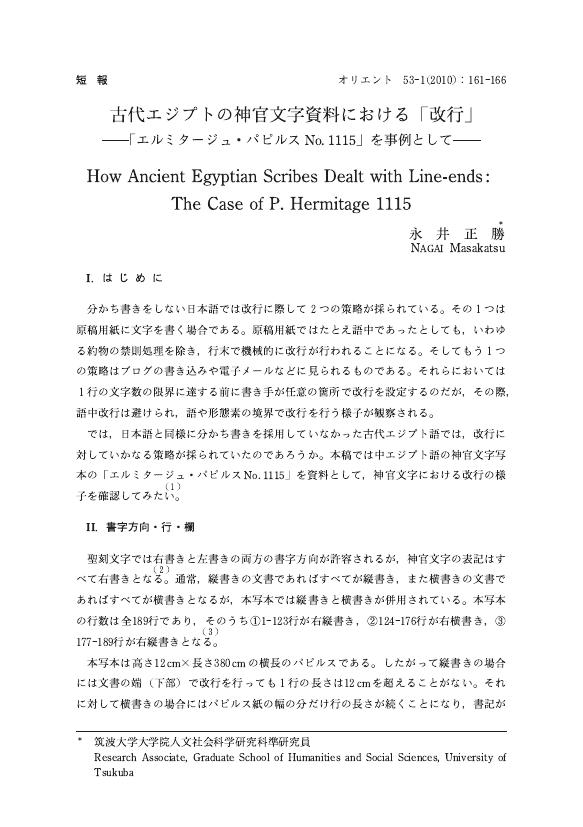- 著者
- 冨澤 かな 木村 拓 成田 健太郎 永井 正勝 中村 覚 福島 幸宏
- 出版者
- 一般社団法人 情報科学技術協会
- 雑誌
- 情報の科学と技術 (ISSN:09133801)
- 巻号頁・発行日
- vol.68, no.3, pp.129-134, 2018-03-01 (Released:2018-03-01)
東京大学附属図書館U-PARL(アジア研究図書館上廣倫理財団寄付研究部門)は,本学所蔵資料から選定した漢籍・碑帖拓本の資料画像をFlickr上で公開している。資料のデジタル化とアーカイブ構築のあり方を模索した結果,限られたリソースでも実現と持続が可能な,小さい構成でありながら,広域的な学術基盤整備と断絶せず,高度な研究利用にも展開しうる,デジタルアーカイブの「裾野のモデル」を実現しうる方策として選択したものである。その経緯と現状及び今後の展望について,特に漢籍・碑帖拓本資料の統合メタデータ策定,CCライセンス表示,OmekaとIIIFを利用した研究環境構築の試みに焦点をあてて論ずる。
33 0 0 0 OA <書評>聖刻文字版『ピーターラビットのおはなし』
- 著者
- 永井 正勝
- 出版者
- 筑波大学一般応用言語学研究室
- 雑誌
- 言語学論叢 (ISSN:0914966X)
- 巻号頁・発行日
- no.24, pp.55-66, 2005-12-31
33 0 0 0 OA ギルガメシュ叙事詩の編集史的研究および物語言語研究のためのデジタルアーカイブ構築
本研究は、前二千年紀から前一千年紀にかけて、古代オリエント地方で広く親しまれたギルガメシュ叙事詩のデジタル・アーカイブを構築するものである。ギルガメシュ叙事詩は、前二千年紀初頭に成立した古バビロニア語版と、前二千年紀末に成立した標準版が、ある程度現存している。そこで、古バビロニア語版と標準版の異同をデジタル処理可能なかたちでアーカイブ化することで、テクストの対応関係ならびに発展段階をある程度まで可視化することができた。本研究で開発されたデジタル化の枠組みは、言語研究や文学研究に広く応用することが可能である。
17 0 0 0 OA Linked Data化した典拠データとIIIFを用いた法帖の異版比較支援システムの開発
- 著者
- 中村 覚 成田 健太郎 永井 正勝
- 雑誌
- じんもんこん2018論文集
- 巻号頁・発行日
- vol.2018, pp.297-302, 2018-11-24
法帖の研究において,版の異同を検討し,その系統を詳らかにすることは肝要である.本研究ではこのような法帖研究の支援を目的として,法帖における異版作品の比較を支援するシステムを開発した.典拠データのLinked Data 化と,複数機関が提供するIIIF 準拠画像に対するアノテーション付与による個別作品の識別により,異版関係にある個別作品を検出可能なシステムを構築した.国立国会図書館,国文学研究資料館,東京大学附属図書館が提供する法帖画像を対象としたケーススタディを通じ,版6 件,著者252 件,作品902 件,異版作品1403 件から構成される典拠データの作成,および213 件の個別作品に対して紐づけを行い,任意の異版作品の異なる個別資料における再現例を検出できることを確認した.
12 0 0 0 OA 古代エジプトの神官文字資料における「改行」
- 著者
- 永井 正勝
- 出版者
- 一般社団法人 日本オリエント学会
- 雑誌
- オリエント (ISSN:00305219)
- 巻号頁・発行日
- vol.53, no.1, pp.161-166, 2010-09-30 (Released:2014-03-31)
- 被引用文献数
- 1
5 0 0 0 必携入門ヒエログリフ : 基礎から学ぶ古代エジプト語
4 0 0 0 OA 古代エジプト聖刻文字の書字方向 : 一般統字論構築の一助として
- 著者
- 永井 正勝
- 出版者
- 筑波一般言語学研究会
- 雑誌
- 一般言語学論叢 (ISSN:13443046)
- 巻号頁・発行日
- no.8, pp.21-45, 2005-12-31
3 0 0 0 IR 表記形式と言語形式のポーカーフェース : 中エジプト語にみる文献言語研究の難しさ
- 著者
- 永井 正勝
- 出版者
- 筑波大学文藝・言語学系
- 雑誌
- 文藝言語研究. 言語篇 (ISSN:03877515)
- 巻号頁・発行日
- no.63, pp.53-67, 2013
3 0 0 0 Hieratische Paläographie DBの構築
- 著者
- 中村 覚 永井 正勝 和氣 愛仁 高橋 洋成
- 雑誌
- じんもんこん2020論文集
- 巻号頁・発行日
- no.2020, pp.191-196, 2020-12-05
- 著者
- 永井 正勝 和氣 愛仁 高橋 洋成
- 雑誌
- 研究報告人文科学とコンピュータ(CH) (ISSN:21888957)
- 巻号頁・発行日
- vol.2019-CH-119, no.14, pp.1-7, 2019-02-09
一般言語学的なスタンスで様々な時代や地域の言語を統一的に扱おうとした場合に,どのような言語学的データの整理の仕方が必要なのかという観点は,データベース構築の際のプラクティカルな問題であると同時に,その整理行為そのものが,言語のあり方を記述する記述言語学の一形態としての価値を有する.本発表では,このような問題意識のもと,文字の直線的な羅列のみを見ていても言語構造が見え難いような文字資料をも対象としつつ,文字資料が持つ情報の,何を,どのように,整理 ・ 構造化して,それらを情報処理に結びつけていくべきなのか,という点について言語学の立場から提案を行う.
- 著者
- 高橋 洋成 永井 正勝 和氣 愛仁
- 出版者
- 一般社団法人情報処理学会
- 雑誌
- 研究報告人文科学とコンピュータ(CH)
- 巻号頁・発行日
- vol.2015, no.5, pp.1-5, 2015-01-24
近年のコンピュータとインターネットの発展に伴い,これまでコンピュータ上では転写テキストとして扱われることの多かった言語資料を,音声,動画,画像と一緒に保存・利用することが容易になった.著者らは古代エジプト神官文字文書,楔形文字粘土板資料,近代日本語文典資料などの文字資料を統一的に扱うための画像データベースと,World Wide Web 上のプラットフォームを構築している.さらに,本プラットフォームは次の 2 点を目指している.(1) 本プラットフォームの内部に格納された言語資料および研究データを,外部に保存し共有するために Text Encoding Initiative (TEI) を利用すること.(2) データの保存と共有をさらに促進させるために,言語資料と研究データに関する RDF トリプルを生成し,Linked Open Data (LOD) として提供すること.本稿はこの 2 点について,現在までの取り組みと具体例を報告する.Recent development of the internet and computer technologies makes it easier to compile various linguistic materials such as audios, videos and photos with their transliteration texts together. The authors are constructing the general-purpose image database and the platform on World Wide Web for the linguistic studies on hieratic texts of Ancient Egypt, cuneiform tablets of Ancient Orient, and Modern Japanese Grammar Textbooks. The platform aims on the following two points: (1) to use Text Encoding Initiative (TEI) for preservation and sharing of the internal data with its outer world, (2) to create sharable RDF triples from the data to provide them as Linked Open Data (LOD). The current snapshot of the developing platform will be discussed.
- 著者
- 永井 正勝 Nagai Masakatsu
- 出版者
- 筑波大学文藝・言語学系
- 雑誌
- 文藝言語研究. 言語篇 (ISSN:03877515)
- 巻号頁・発行日
- vol.58, pp.43-54, 2010-10-31
3 0 0 0 OA 後期ポロツキー説における中エジプト語の文/節体系
- 著者
- 永井 正勝
- 出版者
- 一般社団法人 日本オリエント学会
- 雑誌
- オリエント (ISSN:00305219)
- 巻号頁・発行日
- vol.43, no.1, pp.19-39, 2000-09-30 (Released:2010-03-12)
- 参考文献数
- 27
The main subject of Middle Egyptian studies should be to seek its “langue” through careful analysis of the instances of “parole.” But many Egyptologists, such as Erman, Sethe, and Gardiner, did not fully recognize the importance of the “langue” of Middle Egyptian, instead they paid great attention to the study of morphological differences in the instances of “parole” themselves, and adapted the Semitic system to these differences. From the point of linguistics, however, morphological studies that are separated from the “langue” may possibly lead to misunderstandings of language.It was the linguist Hans Jakob Polotsky who first established the Middle Egyptian “langue” system through the analysis of grammatical categories and syntax. The German scholar Friedrich Junge also developed his grammatical study based on syntax and the “transformationsgrammatik” of Chomsky. By so doing, Polotsky and Junge disproved of the old-fashioned method of the Egyptologists' “Morphological Grammar, ” but there are also differences in the understanding of Middle Egyptian sentence system between Polotsky and Junge. Despite these differences, Leo Depuydt combined these two distinct studies and gave them the label “Standard theory.” Nowadays many scholars regard Polotsky's Idea as “Standard theory” according to Depuydt's terminology. It must be noted, however, that such a label is quite unsatisfactory since “Standard theory” does not equal to Polotsky's Idea, and that the very main point of Polotsky's Idea has been neglected by using such an unfortunate label. It is now clear that the subject with which we must grapple is to clarify the main point of Polotsky's Idea.In this paper I will examine Polotsky's Idea and point out the following Middle Egyptian sentence system explained by Polotsky. 1) There is a distinction of mode in Middle Egyptian. 2) The indicative mode of the main sentence is introduced by an auxiliary and has three tenses (i. e., present, past, future). 3) Some of the main sentences of indicative mode (1st tenses) have their counterparts in the emphasized adverbial sentences (2nd tenses). 4) The emphasized adverbial sentences in initial position (2nd tenses) begin with bare sdm. f/sdm. f form. 5) The prospective mode in the main sentence is expressed by bare sdm. f form.
2 0 0 0 動向 コーパスの設定から見た新エジプト語の文法書
- 著者
- 永井 正勝
- 出版者
- 早稲田大学エジプト学会
- 雑誌
- エジプト学研究 (ISSN:09192417)
- 巻号頁・発行日
- no.12, pp.101-110, 2004-01
2 0 0 0 OA アノテーション付与型画像データベースシステムのための汎用プラットフォーム構築
本研究では、資料画像にテキスト情報を付与し、画像から文字あるいは単語等のテキストデータを検索できるようなシステム(「アノテーション付与型画像データベースシステム」)について、さまざまな人文学資料を共通の枠組で扱うことを可能にするために、共通のユーザインターフェイスと標準的なデータ構造モデルを作成し、汎用データベースプラットフォームシステムを構築した。本研究ではこのプラットフォームを利用し、古代エジプト語神官文字パピルス資料、明治期日本語文典資料、古代シュメール・アッカド語楔形文字年度版資料のデータベースを構築した。
- 著者
- 永井 正勝 Nagai Masakatsu
- 出版者
- 筑波大学文藝・言語学系
- 雑誌
- 文藝言語研究. 言語篇 (ISSN:03877515)
- 巻号頁・発行日
- vol.59, pp.107-125, 2011-03-31
- 著者
- 冨澤 かな 木村 拓 成田 健太郎 永井 正勝 中村 覚 福島 幸宏
- 出版者
- 一般社団法人 情報科学技術協会
- 雑誌
- 情報の科学と技術 (ISSN:09133801)
- 巻号頁・発行日
- vol.68, no.3, pp.129-134, 2018
<p>東京大学附属図書館U-PARL(アジア研究図書館上廣倫理財団寄付研究部門)は,本学所蔵資料から選定した漢籍・碑帖拓本の資料画像をFlickr上で公開している。資料のデジタル化とアーカイブ構築のあり方を模索した結果,限られたリソースでも実現と持続が可能な,小さい構成でありながら,広域的な学術基盤整備と断絶せず,高度な研究利用にも展開しうる,デジタルアーカイブの「裾野のモデル」を実現しうる方策として選択したものである。その経緯と現状及び今後の展望について,特に漢籍・碑帖拓本資料の統合メタデータ策定,CCライセンス表示,OmekaとIIIFを利用した研究環境構築の試みに焦点をあてて論ずる。</p>
- 著者
- 永井 正勝
- 出版者
- The Society for Near Eastern Studies in Japan
- 雑誌
- オリエント (ISSN:00305219)
- 巻号頁・発行日
- vol.53, no.2, pp.34-54, 2011
The sentence apearing in lines 74-75 of <i>P. Hermitage No. 1115</i> has been understood as a negative construction of a progressive sentence, <i>nn sw ḥr sḏm</i>, in many studies. This understanding is based on an assumption that the sign A1 tn the original text is so wrongly written that we should omit it or should emend it to A2. In this way, the transcription <i>nn wi ḥr sḏm st</i> is derived.<br> However, in my opinion, the sign A1 in the original papyrus is the 1st person suffix pronoun<i>=i</i> and the text should be understood as a sentence with an adverbial predicate, <i>nn wi ḥr sḏm=i st,</i> "I am not in the situation that I hear it." In this sentence <i>sḏm=i st</i> is thought of as an unmarked complement clause.<br> As not even one correct example of the <i>nn sw ḥr sḏm</i> has been attested, I would like to propose that this constriction is a ghost form invented by modern scholars. As a result, the paradigm of the imperfective aspect, including the progressive form, would look like this:<br><br> imperfective aspect (intransitive)<br> habitual progressive<br> affirmative <i>iw(=f) sḏm=f </i><i>iw(=f) ḥr sḏm</i><br> negative <i>n sḏm.n=f</i>
- 著者
- 永井 正勝
- 出版者
- The Society for Near Eastern Studies in Japan
- 雑誌
- オリエント (ISSN:00305219)
- 巻号頁・発行日
- vol.53, no.1, pp.161-166, 2010
- 被引用文献数
- 1

